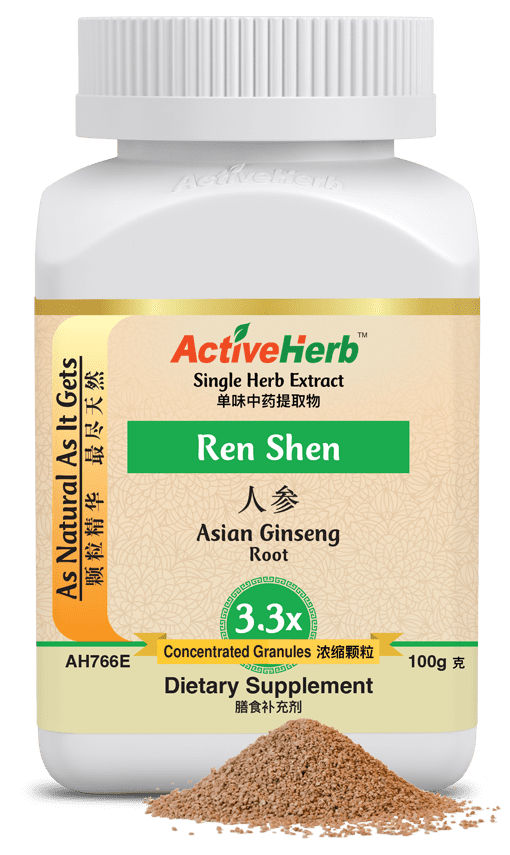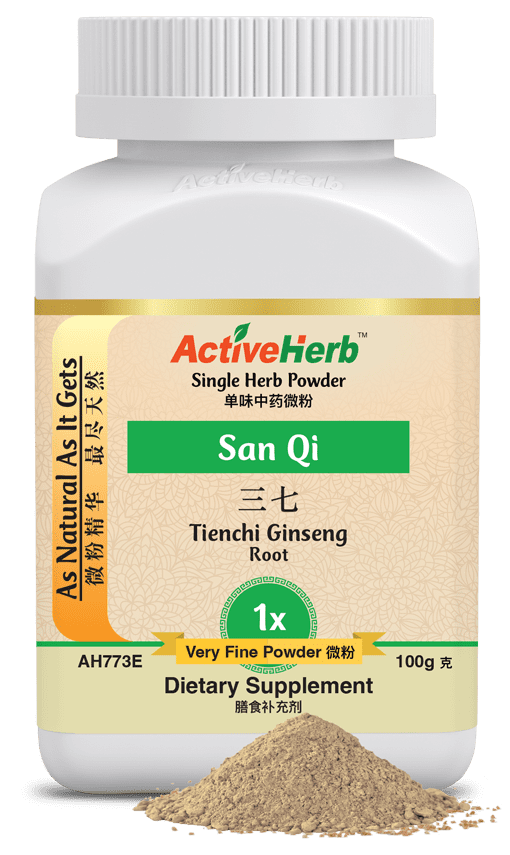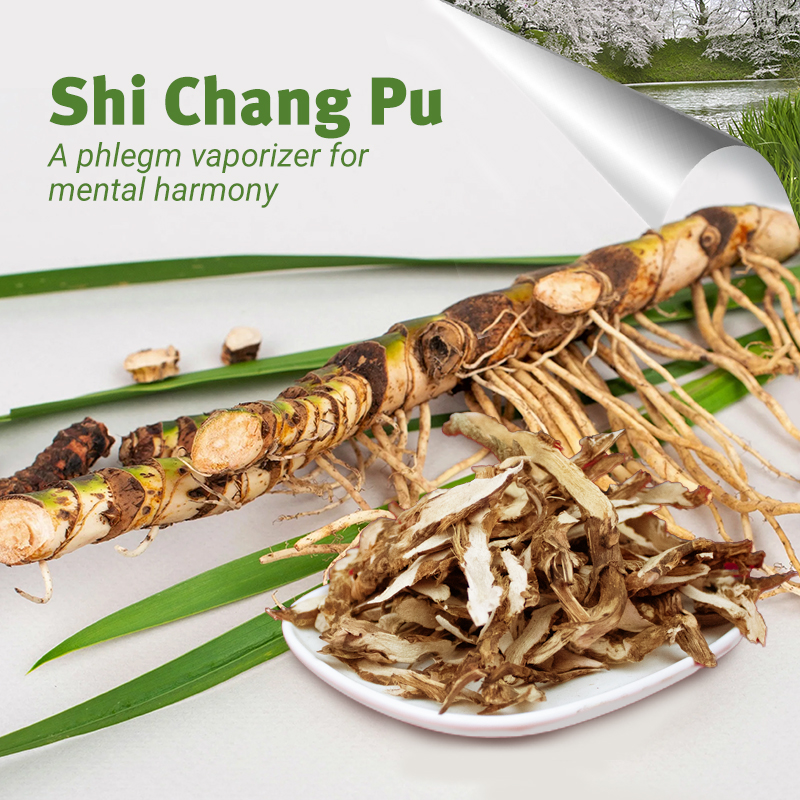A TCM Comparison of Ginsengs
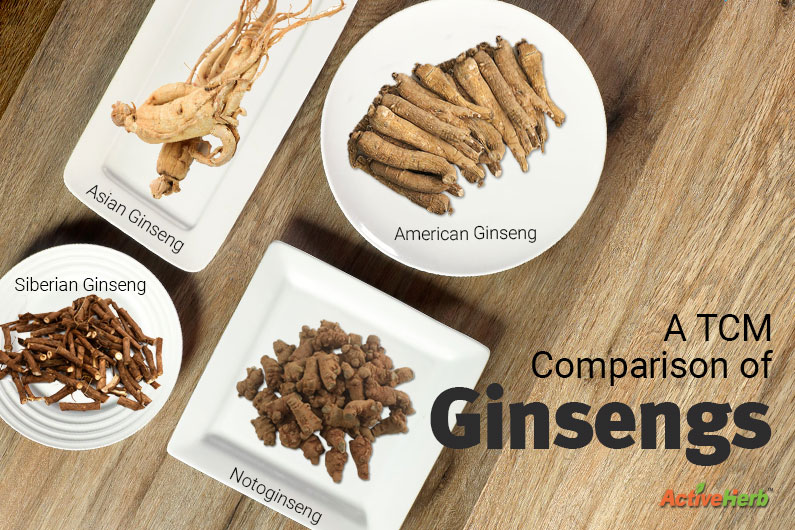
From imperial elixirs to everyday extracts, here’s how several ginseng varieties compare in theory, history, and health benefits…
For thousands of years, ginseng has earned its place as the crown jewel of herbal medicine. It’s an herb so potent and prized that wars were fought over it, emperors hoarded it, and counterfeiters risked their lives forging it. But not all ginsengs are created equal. In fact, some herbs called “ginseng” aren’t true ginsengs at all.
In Traditional Chinese Medicine (TCM), there are at least four herbs popularly associated with the name “ginseng,” each with distinct properties, applications, and historical lore:
- Ren Shen (Panax ginseng, Asian ginseng)
- San Qi (Panax notoginseng, Notoginseng)
- American Ginseng (Panax quinquefolius)
- Eleuthero (Eleutherococcus senticosus, a.k.a. Siberian ginseng)
Together, these roots form a fascinating case study in how nature, history, and culture intersect in TCM..
Let’s start with the king of kings…
Ren Shen (Asian Ginseng)
“The Original Qi Charger: Used by Emperors, Laborers, and the Burned-Out Alike”
In TCM, Ren Shen (人参)—also known as Panax ginseng—is the undisputed king of tonic herbs. The name Panax itself comes from the Greek panacea, meaning “cure-all,” and its status as the premier Qi-tonifying herb has made it a staple of imperial apothecaries, battlefield survival formulas, and modern wellness routines alike. In TCM, Ren Shen is used when someone’s energy tank isn’t just low—it’s empty.
How Far Back Does Ginseng Go?
The use of ginseng in Chinese medicine dates back over 2,000 years. The Shennong Bencao Jing (Divine Farmer’s Classic of Materia Medica), the foundational herbal text from the Han Dynasty, lists Ren Shen as a “superior herb”—those that “prolong life, prevent aging, and support the spirit.” Ginseng was so prized in ancient China that wild roots were often worth their weight in gold. By the Tang Dynasty (618–907 AD), Korea became a major hub for ginseng cultivation, and the herb’s fame spread across Asia and eventually to Europe by the 17th century.
Emperors used it to maintain stamina and virility. Poor farmers used it sparingly, saved like treasure, to recover from childbirth, fevers, or extreme fatigue.
What Ren Shen Does in TCM
Ren Shen is warm, sweet, and slightly bitter. It enters the Lung and Spleen meridians and is used to powerfully tonify Yuan Qi (original or source Qi). If Qi is the life force that animates every cell and organ, Yuan Qi is the battery pack you’re born with. Ren Shen plugs directly into that reserve.
TCM patterns and symptoms Ren Shen supports include:
- Spleen Qi Deficiency: Fatigue, poor appetite, loose stools, and bloating after meals.
- Lung Qi Deficiency: Shortness of breath, weak voice, spontaneous sweating.
- Qi and Blood Collapse: Shock, hemorrhage, or critical illness.
- Heart Qi and Spirit Deficiency: Palpitations, forgetfulness, anxiety, insomnia.
This herb doesn’t just stimulate—it rebuilds. It’s for people who are “burned out at the root,” not just those needing a pick-me-up. For this reason, it’s often reserved for those truly depleted or recovering from major illness.
Doctrine of Signatures: A Root That Looks Like You
Ren Shen often looks eerily human. Some roots resemble figures with arms, legs, even genitalia—hence the name “man root” in both Chinese (Ren Shen) and Latin (Panax ginseng). According to the Doctrine of Signatures, this resemblance implies its use in whole-body revitalization. The twisted arms and legs mirror ginseng’s ability to revive the limbs and restore strength. Some say the more human-shaped the root, the more potent the Qi.
The root’s yellowish tone also aligns with the Earth element in TCM, which governs digestion (Spleen-Stomach) and overall nourishment.
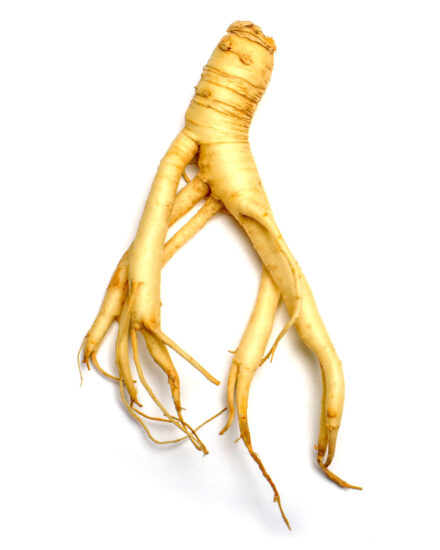
What the Ren Shen Research Says
Modern research—such as a 2024 meta-analysis published in Phytotherapy Research—has confirmed many of ginseng’s traditional uses:
- Immunity: Ginsenosides, the primary active constituents, enhance phagocytic activity and modulate immune responses. (Phagocytes are the Pac-Man-like white blood cells that gobble up harmful pathogens.)
- Energy & Cognitive Function: Ginseng has been shown to support mental performance, reduce fatigue, and regulate adrenal function.
- Circulation & Blood Sugar: A 2014 meta-analysis in PLOS One found that ginseng supported fasting blood glucose and postprandial insulin levels.
- Nitric Oxide Support: In animal studies, ginsenosides increase nitric oxide production, promoting vasodilation and improved circulation, including to sexual organs.
For people with Qi Deficiency from overwork, chronic health issues, or aging, ginseng acts like a backup generator—restoring the current when your internal battery can’t keep up.
From Emperor’s Root to CEO’s Chill Pill
If Ren Shen is the fiery emperor’s fuel—used for restoring depleted power and pushing through battle fatigue—then American ginseng might be the antidote to modern hustle culture. Think of the burned-out tech executive, the anxious insomniac, or the overheated type-A go-getter who’s wound too tight to wind down. For them, Panax quinquefolius may be what the TCM doctor ordered.
American Ginseng (Panax quinquefolius)
“Canadian Discovery, American Calm: The Yin Counterpart to Ren Shen”
Discovered not in a Chinese forest nor the USA but in the woods of Montreal in the early 18th century, American ginseng quickly captivated both Indigenous communities and European traders. Jesuit priests observed Native American healers using the root for fevers, digestion, and as a general tonic. When they recognized its similarity to the prized Ren Shen of China, a ginseng export economy was born—rooted (pun intended) in the Canadian wilderness.
Within decades, the U.S. had joined the frenzy. As mentioned in the New York Times, Daniel Boone and other frontiersmen collected wild ginseng for export to China, where it was thought to be more potent than even some Asian varieties due to the soil and climate of North America. By the mid-1800s, over 350 tons of American ginseng were being exported to China annually.
What Makes It Different in TCM
Unlike its fiery Asian cousin, American ginseng is cooling in nature. While Ren Shen tonifies Yang Qi (outward, warming energy), American ginseng nourishes Yin Qi—the quiet, moistening, inward energy that cools and soothes.
This makes it ideal for people who are:
- Burned out and overheated.
- Experiencing night sweats, dry mouth, or fatigue with irritability.
- Recovering from febrile illness or adrenal overstimulation.
In TCM, American ginseng enters the Heart, Lung, and Kidney meridians (not the physical organs). It’s especially helpful when Qi and Yin are both deficient—a condition often caused by chronic stress, poor sleep, and stimulant overuse.
TCM Patterns Supported by American Ginseng:
- Yin Deficiency with Heat Signs: Dry cough, sore throat, restlessness, night sweats.
- Qi and Yin Deficiency: Fatigue with dryness, low-grade fever, dry mouth, or irritability.
- Post-Fever Recovery: Rebuilding fluids and calming the mind after extended illness.
A Cooler Root, A Different Signature
While Ren Shen roots often resemble a squat, muscular figure, American ginseng tends to grow longer and leaner—like a willowy, introspective cousin. Its paler color and subtler bitterness mirror its Yin-nourishing nature. Under the Doctrine of Signatures, its milder flavor and more delicate features point to a more cooling, moistening influence—just what the overcooked constitution craves.
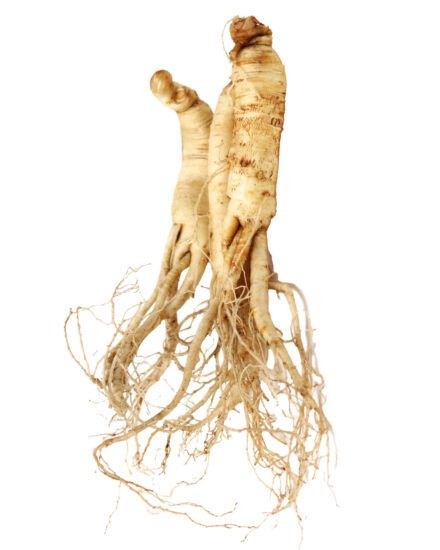
What the Research Says
Several studies affirm American ginseng’s adaptogenic and Yin-nourishing effects:
- A study in Journal of Ethnopharmacology found it supported memory in healthy adults under stress.
- In Traditional Chinese Medicine practice, it’s frequently recommended for dry coughs and lung Yin Deficiency, and one clinical review noted its supportive effects for respiratory health.
- Like Asian ginseng, it has also been investigated for blood sugar support.
Modern Applications
American ginseng isn’t for everyone. If you’re cold, sluggish, and Qi-deficient, Ren Shen is likely the better choice. But if you’re burned out, wired-tired, and running too hot—think of American ginseng as your herbal AC unit: quiet, cool, and calming.
From Calm to Circulation: Not All Ginsengs Tonify the Same Way
If American ginseng is the soothing Yin-tonic for the burned-out, overworked modern dweller, then San Qi is the warrior’s wound remedy—a ginseng cousin revered not for energy or calm, but for its powerful ability to stop bleeding, invigorate Blood, and dissolve trauma, both physical and emotional. Let’s head to Yunnan province, where San Qi earned its legendary nickname: the “Three-Seven Root.”
San Qi (Notoginseng)
“Ginseng’s Gritty Cousin With a Heart of Gold”
San Qi (三七), also known as Notoginseng or Tian Qi, isn’t technically ginseng—though it often rides its more famous cousin’s coattails. It belongs to the same genus, Panax, and shares many phytochemicals, particularly saponins. But in TCM, San Qi has a reputation all its own: not as a Qi-tonifier like Ren Shen, but as a blood-mover and trauma-healer. In fact, it’s one of the most revered hemostatic herbs in the Chinese pharmacopeia—used to both stop bleeding and support circulation.
Blood, Bullets, and Botanicals
San Qi’s rise to fame came not in imperial palaces, but on the battlefield. During the Ming Dynasty (1368–1644), a herbalist named Li Shizhen—the author of the monumental Bencao Gangmu (Compendium of Materia Medica)—wrote that San Qi was so powerful at stopping internal and external bleeding that it was “more valuable than gold.” That reputation followed it through the ages. During the Vietnam War, soldiers reportedly carried powdered San Qi in their field kits to stop hemorrhaging wounds. To this day, it remains the principal ingredient in the famed emergency hemostatic formula Yunnan Baiyao.
What San Qi Does in TCM
In Chinese medicine, San Qi is classified under herbs that stop bleeding (Huoxue Zhi Xue Yao), but its strength is in versatility. While it halts bleeding (both internal and external), it also invigorates the Blood, resolving blood stasis and easing pain. That dual nature—stopping bleeding while promoting flow—makes San Qi unique.
From a pattern perspective, San Qi is used in formulas for:
- Blood stasis with pain or trauma
- Internal bleeding (ulcers, uterine bleeding, blood in stool or urine)
- Cardiovascular concerns (e.g., chest Bi syndrome, angina)
- Sports injuries and joint pain
- Post-surgical bruising or swelling
Unlike Ren Shen, which restores energy slowly over time, San Qi is used in more acute or injury-based scenarios, but it’s also gaining attention as a daily tonic for circulation and cognitive clarity.
A Very “Knotty” Herb
San Qi root looks rugged—bumpy, knotted, and dense—like a little brain or a chunk of petrified wood. This appearance, according to the Doctrine of Signatures, symbolizes its role in breaking through stagnation, smoothing obstructions, and resolving internal “knots” in blood flow. The reddish-brown hue of the root nodules also mirrors the color of Blood, reinforcing its role as a blood-regulating herb.
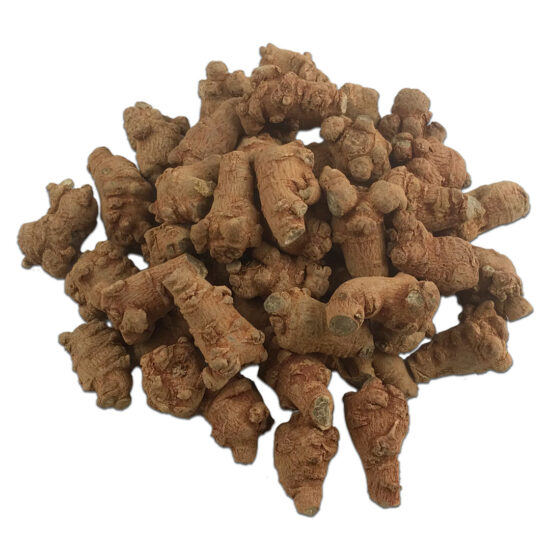
What the Research Says
Modern studies support what TCM has known for centuries. A randomized controlled study published in the Journal of Strength and Conditioning Research found that supplementing with San Qi improved aerobic capacity and blood pressure regulation in young adults, likely through vasodilation and nitric oxide modulation.
Other studies have explored San Qi’s effects on supporting brain- and cognitive health, as well as normal inflammatory levels. But there’s more to the biomolecular story: The ginsenosides in Notoginseng have also demonstrated potential in supporting oxidative stress levels and protecting vascular endothelial cells, which may have future implications for stroke recovery and long-term brain health.
From Root to Rocket Fuel: The Soviet Union’s Secret Weapon
After San Qi, the next stop on our herbal tour isn’t in the Americas or China, or even Japan or Korea. It’s Siberia, where icy winds whip across vast boreal forests (the “taiga) and the demands on human endurance—and plants—are relentless. Here grows Eleutherococcus senticosus, commonly called Siberian ginseng or Eleuthero, (“Ci Wu Jia” in TCM). Though not a true ginseng botanically, the Soviets saw its potential. And what started as folk medicine in Siberia would soon be tested in Olympic athletes, cosmonauts, and soldiers.
Siberian Ginseng (Eleutherococcus senticosus)
“The People’s Adaptogen: From Taiga Roots to Space Capsules”
While Ren Shen was reserved for emperors, Siberian ginseng was the root of the people. Used traditionally in Russian and Chinese folk medicine, Eleuthero caught the attention of Soviet scientists in the 1950s as they scoured the herbal world for safe, legal performance enhancers. Their goal? Increase human resilience under extreme stress—whether in battlefields, Olympic arenas, or outer space.
Dr. Israel Brekhman, a Russian pharmacologist, led a series of landmark studies, coining the term “adaptogen” to describe Eleuthero’s ability to help the body adapt to physical, mental, and environmental stressors—without the crash of stimulants.
It was given to:
- Cosmonauts during space missions
- Athletes during the 1980 Moscow Olympics
- Submarine crews, factory workers, and soldiers
In TCM Terms: Not Ginseng, But Still Powerful
Although it doesn’t belong to the Panax family, Ci Wu Jia fits snugly in the category of herbs that tonify the Spleen and tonify Qi. But its applications go beyond just Qi.
TCM Uses and Patterns:
- Qi Deficiency with Fatigue: Especially when caused by overwork or recovery.
- Spleen and Kidney Yang Deficiency: Cold limbs, poor digestion, and lack of stamina.
- Liver Qi Stagnation with Weakness: When emotional stress depletes physical strength.
- Wei Qi Deficiency: Prone to catching colds or lacking immune defense.
Unlike Ren Shen, which can be too heating for some, Ci Wu Jia is neutral in nature—making it suitable for longer-term use and a wide range of constitutions.
Doctrine of Signatures
With its rugged, woody stems and thorny demeanor, Eleuthero doesn’t look delicate—and that’s the point. Its sprawling root system and cold-resistant habitat reflect its job: build resilience. In Doctrine of Signatures language, Eleuthero’s harsh terrain and hardy constitution signal its function in helping the human body adapt to stressful demands.
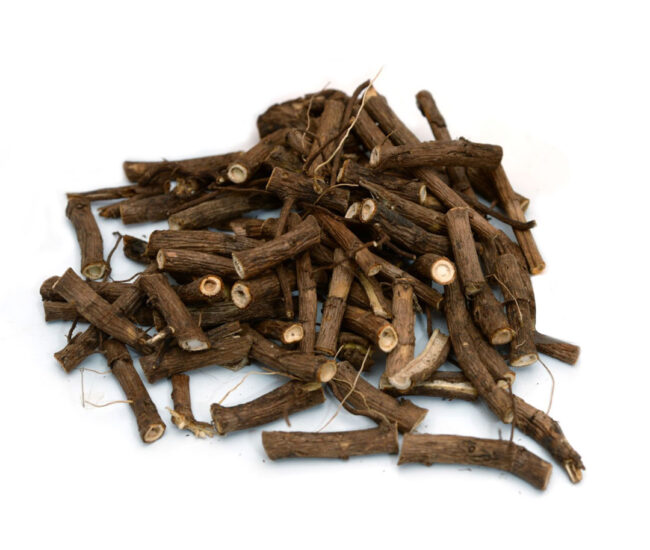
Who Should Take Eleuthero?
If you’re:
- Tired but still wired
- Dealing with physical or emotional stress
- Looking for sustainable, long-term energy without stimulation…
…Eleuthero might be your root. It’s less about peak performance and more about durability. Think of it as the herbal equivalent of a well-oiled engine that just keeps going—reliably, quietly, efficiently.
Beyond the Big Four: Pseudo-Ginsengs & Herbal Lookalikes
As you can tell by now, not all “ginsengs” are created equal—or even ginseng at all!
Take Cistanche (Rou Cong Rong), often dubbed the “Desert Ginseng.” Found in the arid regions of China and Mongolia, this Yang-tonifying herb doesn’t share botanical roots with true ginseng but has earned its nickname for its reputation in enhancing vitality, fertility, and sexual stamina. In TCM, it’s used to tonify Kidney Yang and Jing, supporting reproductive function and relieving constipation in the elderly—a far cry from the energy-boosting roles of Panax varieties, yet equally revered in its own right.
Then there’s Ashwagandha, often called “Indian Ginseng.” Again, not botanically related to Panax, but its adaptogenic properties make it a staple in Ayurvedic medicine for stress resilience, much like Eleuthero.
Even Dang Gui (Angelica sinensis) has been dubbed “Female Ginseng” for its profound effects on blood nourishment and menstrual health.
These ginseng-adjacent herbs may not belong to the Panax family, but they reflect a universal herbal truth: Vitality has many roots (perhaps pun intended).
The Final Word: Which Ginseng is Right for You?
Whether you need the:
—Hard-charging, Qi-building power of Ren Shen;
—Cool, restorative calm of American Ginseng;
—Circulation-enhancing force of San Qi;
—Or the stress-shielding endurance of Eleuthero…
…TCM has a ginseng—or pseudo-ginseng—for nearly every constitution and life stage.
Just remember:
- If you’re wiped out and cold, warm up with Ren Shen.
- If you’re run down and hot, cool down with American Ginseng.
- If you’re bruised, inflamed, or stagnant, move Blood with San Qi.
- If you’re burning out, fortify your resilience with Eleuthero.
This is a generalization of the differences; for best results or when in doubt, consult a licensed TCM practitioner. After all, in TCM, vitality isn’t just about more energy. It’s about the right energy, at the right time, in the right form.
Ready to Experience the Gold Standard in Ginseng?
At ActiveHerb.com, every ginseng product is rigorously tested for purity, potency, and safety. Our concentrated herbal granules deliver consistent, clinically effective doses in every serving—no fillers, no fluff. Discover the highest-quality ginseng extracts trusted by TCM professionals and wellness seekers alike.
Shop the full ginseng collection here.
Related Posts:
This is the King of All Herbs in Chinese Medicine
San Qi: Nourish Your Blood With Notoginseng
Cistanche in TCM: The Vitality-Boosting Miracle of “Desert Ginseng”
What Is Dang Gui (Chinese Angelica Root) Used For In TCM?
References:
Park HJ, Kim DH, Park SJ, Kim JM, Ryu JH. Ginseng in traditional herbal prescriptions. J Ginseng Res. 2012 Jul;36(3):225-41.
Zeng M, Zhang K, Yang J, Zhang Y, You P, Yan L, Weng Y. Effects of Ginseng on Cognitive Function: A Systematic Review and Meta-Analysis. Phytother Res. 2024 Dec;38(12):6023-6034.
Shishtar E, Sievenpiper JL, Djedovic V, Cozma AI, Ha V, Jayalath VH, Jenkins DJ, Meija SB, de Souza RJ, Jovanovski E, Vuksan V. The effect of ginseng (the genus panax) on glycemic control: a systematic review and meta-analysis of randomized controlled clinical trials. PLoS One. 2014 Sep 29;9(9):e107391.
Han SW, Kim H. Ginsenosides stimulate endogenous production of nitric oxide in rat kidney. Int J Biochem Cell Biol. 1996 May;28(5):573-80. Scholey A, Ossoukhova A, Owen L, Ibarra A, Pipingas A, He K, Roller M, Stough C. Effects of American ginseng (Panax quinquefolius) on neurocognitive function: an acute, randomised, double-blind, placebo-controlled, crossover study. Psychopharmacology (Berl). 2010 Oct;212(3):345-56.
Alsayari A, Muhsinah AB, Almaghaslah D, Annadurai S, Wahab S. Pharmacological Efficacy of Ginseng against Respiratory Tract Infections. Molecules. 2021 Jul 5;26(13):4095.
Chen W, Balan P, Popovich DG. Review of Ginseng Anti-Diabetic Studies. Molecules. 2019 Dec 9;24(24):4501.
Zhu Z, Yan W, Yu Q, Wu P, Bigambo FM, Chen J. Association between Exercise and Blood Pressure in Hypertensive Residents: A Meta-Analysis. Evid Based Complement Alternat Med. 2022 Jan 11;2022:2453805.
He B, Chen D, Zhang X, Yang R, Yang Y, Chen P, Shen Z. Oxidative Stress and Ginsenosides: An Update on the Molecular Mechanisms. Oxid Med Cell Longev. 2022 Apr 20;2022:9299574.
Liao LY, He YF, Li L, Meng H, Dong YM, Yi F, Xiao PG. A preliminary review of studies on adaptogens: comparison of their bioactivity in TCM with that of ginseng-like herbs used worldwide. Chin Med. 2018 Nov 16;13:57.



